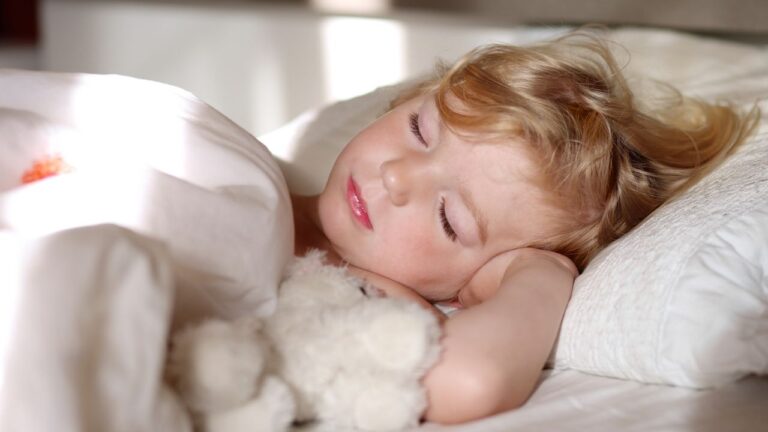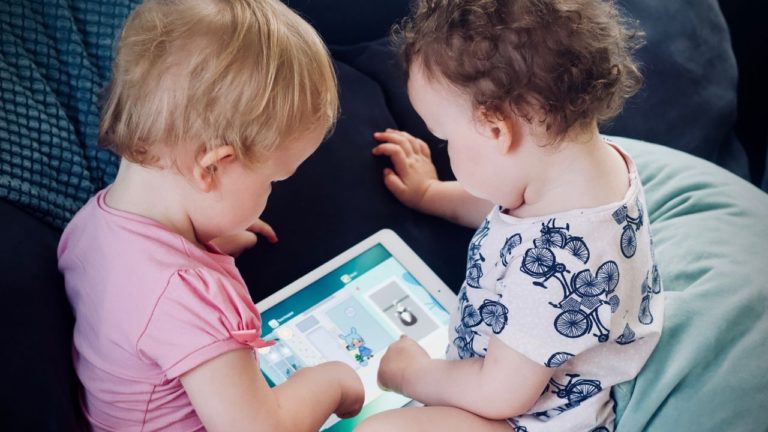18 Engaging Activities to Teach Colors to Toddlers & Preschoolers
This post may contain affiliate links and we may earn commissions when you make a purchase through these links (at no extra cost to you). See our disclosure policy for more details.
How To Teach Small Children About Colors Through Play
Wondering if it’s time to start teaching your kiddo color names? Are you wondering how exactly to go about that in a fun way?
No problem! We’ve got the answers — not to mention some of the easiest, most engaging activities to teach colors to toddlers. And that’s what we’re covering in today’s post.
Toddlerhood is such an exciting time. I think the biggest reason I love these toddler years so much is because of all the things they’re just starting to learn. And the awesome thing is that they learn the most through play!
Learning through play is crucial for toddlerhood and early preschool years. Through experiencing the world around them, children are able to problem-solve, make connections, establish relationships, recall information, and more.
First of all, before we get to that list of color activities, let’s talk about the best time to start teaching colors to your toddler.
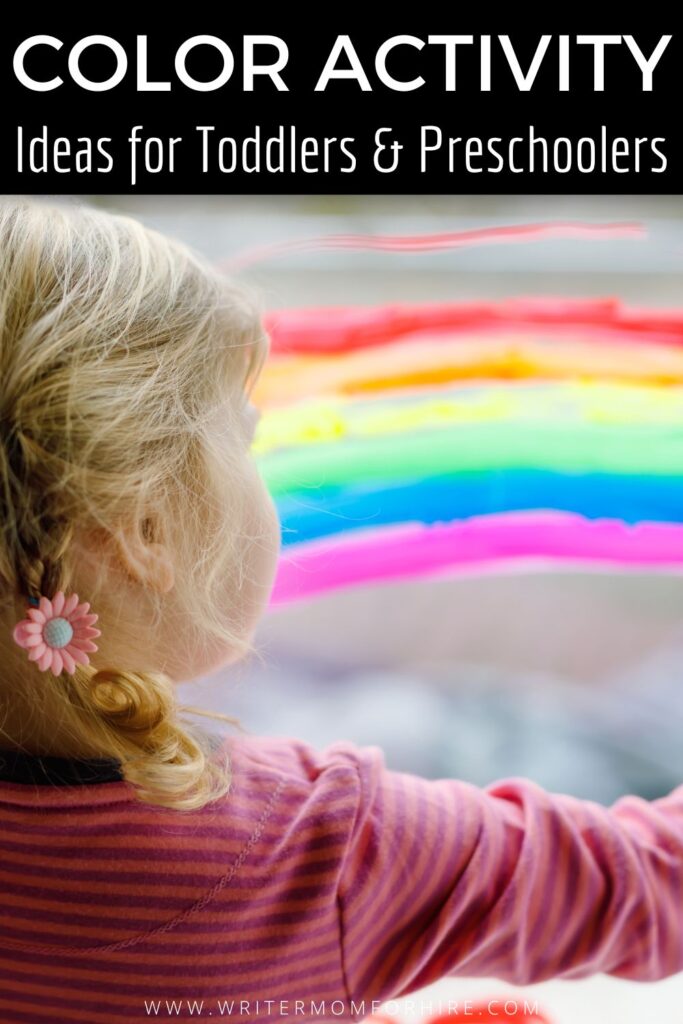
When to Teach Colors to Toddlers
Early toddlerhood is the prime time to build the foundation of a child’s color knowledge. Specifically, around 18 months to age two is a great time to begin seriously focusing on teaching colors (source).
If you see your child take an interest in colors before 18 months, you can absolutely capitalize on that. Whenever you see their interest piqued, run with it.
In other words, strike while the iron is hot!
Some children pick up on these concepts sooner than others, and any pace is perfectly okay. By age three, most children can identify at least one color, and they know quite a few colors by age four.
A Quick Note…
Children can become easily overwhelmed by too much information at once, so keep it as SIMPLE as possible. After all, “everyday learning”, or talking about colors in everyday life, is just as effective as formalized instruction.
Without further delay, let’s get to that list of color learning activities you’re here for!
Activities That Will Help You Teach Colors to Toddlers & Preschoolers
1. Button Sorting Cups
For this activity, you’ll need:
- colorful plastic cups
- colored buttons that match the cups
Have your child work on sorting the buttons by putting them in the corresponding cups. You may need to help them get started, but they should be able to pick it up quickly through trial and error.
This activity works to develop fine motor strength as well as cognitive skills, such as problem-solving, perseverance, and concentration.
2. Rainbow Sorting Necklaces
For this activity, you’ll need:
- Froot Loops
- yarn, ribbon, or a pipe cleaner
Let your child stack Froot Loops onto the yarn/ribbon/pipe cleaner to create a necklace! As they string a certain color Froot Loop onto the necklace, say that color out loud — repetition is how we are able to internalize information over time.
Later, try naming a color and see if your child can find it and add it to the necklace.
3. Finger Painting
Of course, we can’t forget about fingerpainting! It helps with so many areas of development, from fine motor skills to cognitive skills (classifying, persistence, problem-solving, and cause and effect.)
Through fingerpainting, you can work on color identification with your child by having them paint with one color at a time. You can gradually introduce color mixing concepts through this activity.
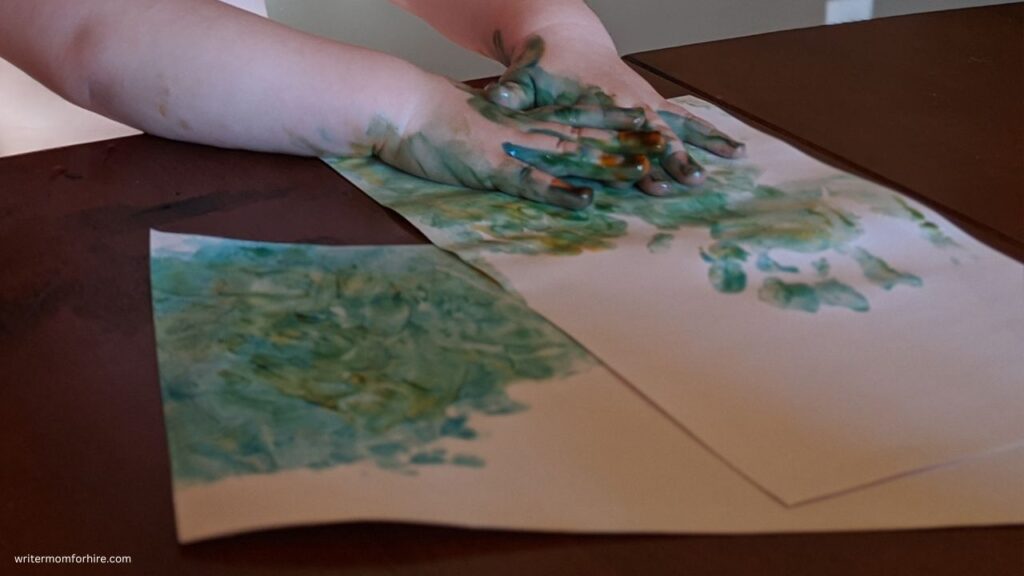
(By the way, Mix It Up! by Herve Tullet is such a fun book to pair with fingerpainting!)
4. Color Sensory Bins
This activity is SO open-ended, and you can even enlist your child to help find the materials.
In fact, they may even be more invested in the activity if they help set it up and choose the materials themselves.
You could do a different colored bin each day, or prolong the process by focusing on a different color each week.
You’ll need:
- containers (these plastic shoe boxes would work perfectly!)
- any materials/toys in the chosen focus color for the bin
- a base of some kind in the focus color (dyed rice makes for an awesome sensory bin base/filler!)
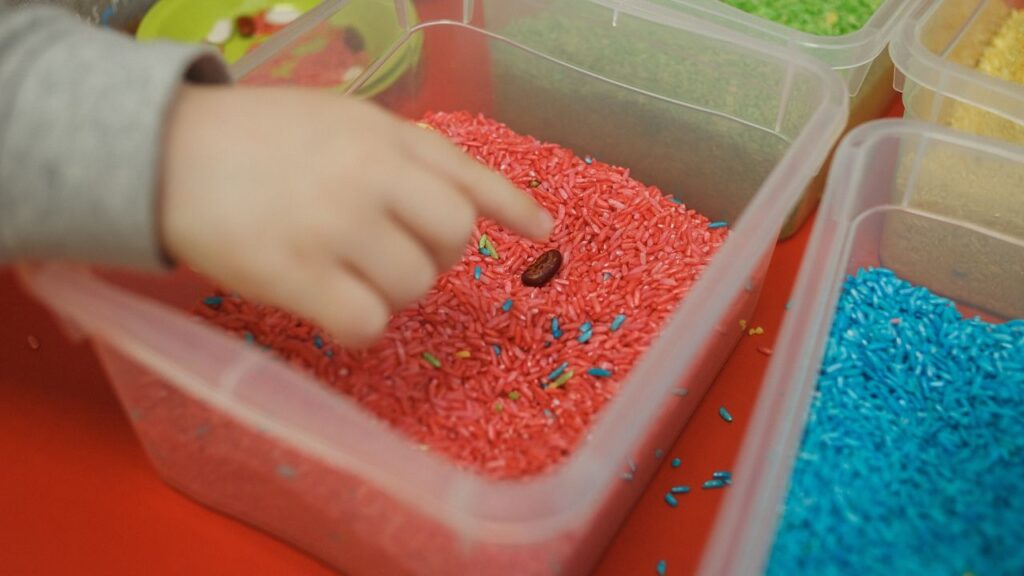
5. Toilet Paper Roll Sorting Game
Save those cardboard rolls, because you’ll be able to put them to good use in this sorting activity! You can also cut a couple of paper towel rolls into 2 or 3 sections if you don’t have enough toilet paper rolls.
First of all:
1. Grab some colored construction paper (make sure to grab some of each color of the rainbow!).
Now, wrap the paper around the cardboard roll and cut it down to size, so that it fits perfectly lengthwise. Secure the paper with some glue or tape.
2. Cut out small circles in each color.
For this step, you can either use construction paper cut into little circles or attach a circle of each color to little wooden discs. If you don’t have discs and the paper is too flimsy on its own, you can also laminate it.
(Make sure to match the colors of the circles to the colors of the tubes, but don’t attach them together.)
3. Glue all the tubes onto a cardboard slab to keep them together in a line.
To play the game:
Put the rounds face down, have your child flip them over one by one, and encourage them to put the correct round into the correct tube.
They’ll eventually be able to do it themselves after some practice.
6. Muffin Tin Pom Pom Matching
Muffin tins make the perfect sorting container! For this matching activity, you’ll need:
- one muffin tin
- construction paper in the colors of the rainbow
- craft poms corresponding to the construction paper colors
Cut out circles of each color to put in the bottom of the muffin tin so each cup has its own color. The goal is to place craft poms into their corresponding color muffin tin cup.
7. Color Matching Parking Lot
Use markers to draw a parking lot on cardboard or a piece of kraft paper. You’ll also want to make sure you have cars of different colors that match each parking spot color.
If you don’t have cars that match the colored parking spots, you could use colored construction paper to make some.
Have your child park each car in the corresponding colored parking spot.
8. Color Toss
This activity is so easy to throw together, and you can just use what you already have on hand!
Find whatever bins you already have (laundry baskets are great!), and use colored paper to assign a color to each bin. Use any colorful items you already have, such as balls or plush toys, and encourage your child to throw them into the corresponding colored bins!
A major key to this activity is modeling. Talk through observations you’re seeing to establish their internal problem-solving and thought processes.
Narrate the colors you see and what you’re doing to sort them. Eventually, they’ll catch on and make similar observations that help them complete the activity correctly.
9. Paper Plate Color Matching
The color wheel is a great way to introduce the way colors relate to one another.
For this one, you’ll need:
- a paper plate
- clothespins
- markers
Color sections of the plate to make a color wheel, and then color the tips of the clothespins to match each section.
Work with your child as they attempt to match the colored clothespins to the colored sections.
The color wheel, for reference:
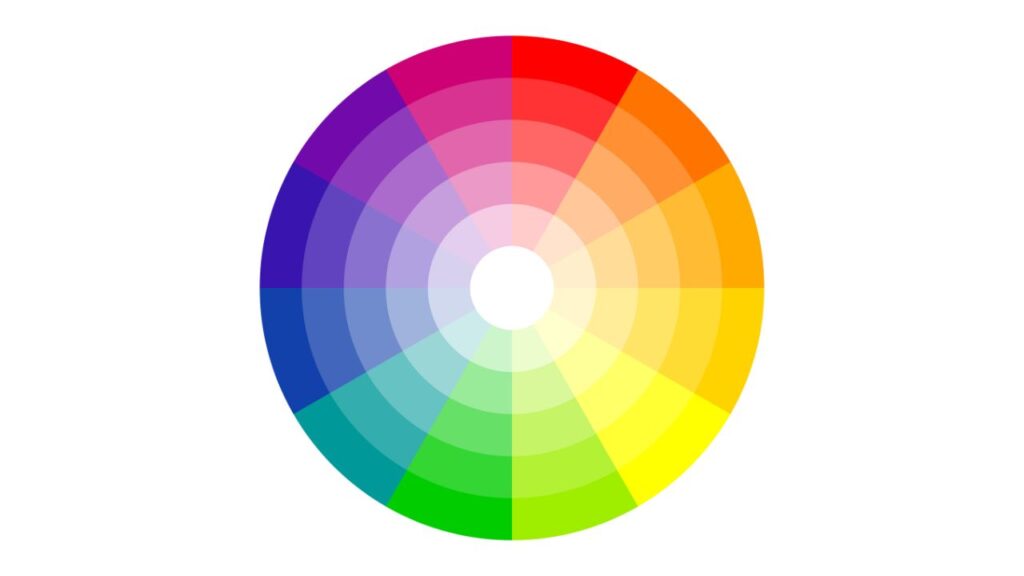
10. DIY Color Wheel
Cut a large circle out of cardboard. Then make different colored triangles to place around the circle (where they belong on the color wheel).
Now round up small, colorful items from around the house for your child to place on the corresponding section of the color wheel.
11. Color Hunt
Time for a scavenger hunt! (One of my girls’ favorite activities.) Walk around the house or yard and make observations.
“That tree’s leaves are green. Do you see that yellow line on the street? Wow, those purple flowers are beautiful!”
You could also collect items in a specific color corresponding with a matching colored bag. For example: Put red construction paper in a Ziploc bag, and fill it with any red items you find.
12. Color Songs
Music and movement is a great vehicle for learning through self-expression! Turn on some cute, fun, and silly songs about colors for your child to dance to and continue to further their knowledge.
You could also add dancing scarves of various colors to your color song dance parties, so they can more actively participate and experience the colors on a deeper level.
13. Scoop and Transfer Color Sort
Get a compartmentalized container or plastic serving tray, and/or just a couple bowls. You’ll also need craft poms (or buttons/small items) and kitchen utensils.
To play:
- Fill one bin with craft poms, provide your child with a utensil or a few, and have them scoop the craft poms from the bowl/bin into the serving tray.
- Once the poms have been moved into the tray, have your child sort the craft poms by color into each compartment.
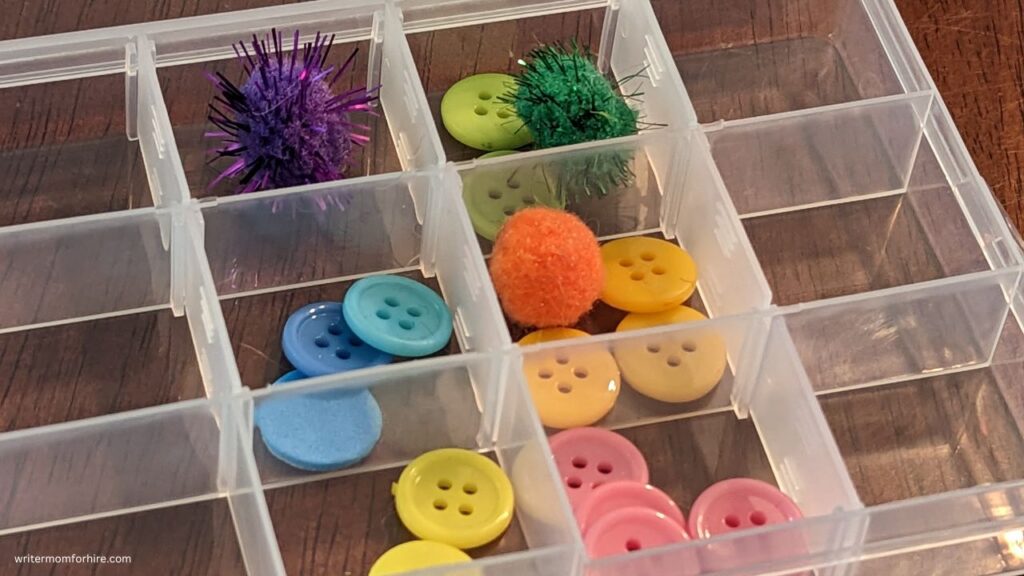
This activity is great for developing hand eye coordination, and it strengthens fine motor skill development.
14. Sticker Sorting Activity
What kid doesn’t love stickers?!
Begin by attaching colored construction paper to the wall or on a flat surface. Then provide your kiddo with stickers and ask them to place each one on the sheet of paper it matches.
Easy peasy!
15. Color Sorting with Cereal
Froot Loops are the focus of this activity! Cut circles out of colored construction paper, and help your child as they sort the Froot Loops onto their corresponding circles.
You could also do this with Skittles or M&Ms or any other multicolored food.
16. Colored “Calm Down Bottles”
You can make this activity very simple. Make sure you have bottles with lids. These empty sensory bottles work great, or you could use an empty plastic Voss water bottle.
You can just put water and food coloring in each one to make the colored calm down bottles.
Or…
You could follow this more detailed recipe that uses water, soap, and glitter. These colored calm down bottles allow for open-ended play, and can assist in taming intense emotions.
Let your child play with these however they desire. It would also be fun to set them on a table or window sill and let the sunlight shine through them.
17. Color Hop
This color hop activity is so simple and engaging, and is an awesome activity for refining gross motor skills! It allows your child to use their whole body to explore their color knowledge
Use chalk on the driveway or sidewalk to make different colored circles. You could also make this an indoor activity by cutting little circles out of colored construction paper.
Then call out the color as you and your child hop onto each spot.
18. Color Collage
For this color collage activity, you’ll need:
- construction paper in various colors
- various craft items and materials corresponding to each color of construction paper
- glue or double sided tape (whatever adhesive is easiest for your child to use. I’ve found glue dots to be relatively easy for toddler hands!)
Invite your child to glue any materials with the corresponding color of paper to each piece of construction paper, creating a fun collage!
Bonus Activity: Rainbow Science Kit
If you like done-for-you activity kits, check out our review of the Rainbow Science kit by Green Kid Crafts. (Spoiler: My girls loved learning about rainbows — and the fun color scavenger hunt — with their kit!).
Green Kid Crafts boxes are fun for kids ages 2-10.
True Colors
These activities will surely assist you in introducing colors to your child! Keep it simple, and utilize what you have on hand.
Almost all of these activities are able to be modified to your needs and to work with what you already have. Remember, the most important thing is to have fun.
Relax and enjoy this interactive learning time with your little one!
Read More:
21 Done-for-You Activity Boxes for 2-Year-Olds
5 Toddler Craft Subscription Boxes (That Busy Moms Will Love!)



